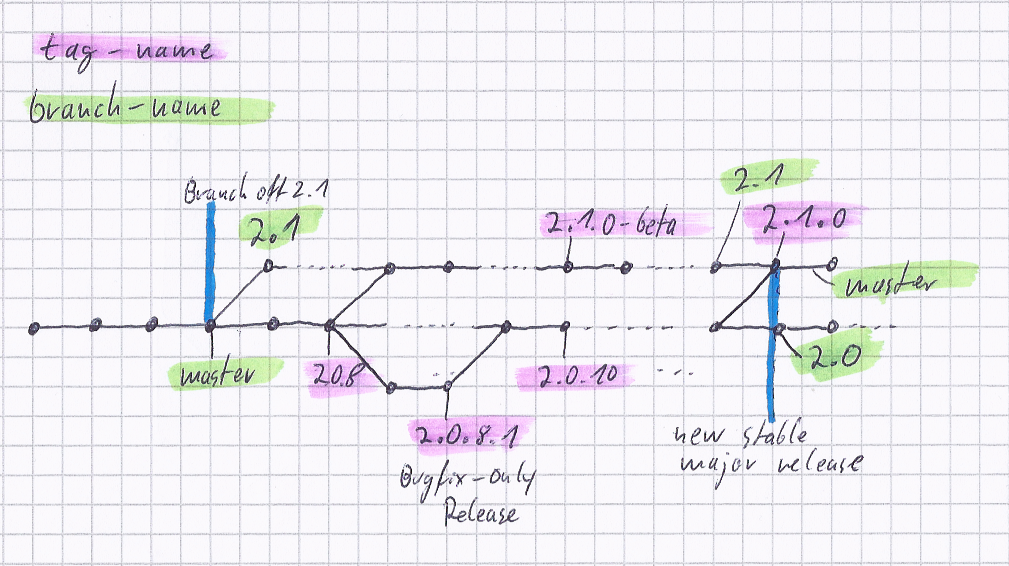This document summarizes the versioning policy of Yii. Our current versioning strategy can be described as ferver, which we considered is more practical and reasonable than Semantic Versioning (See #7408 for more references).
Within the core developer team, we have emphasized several times that it is important to keep 2.0.x releases 100% BC-compatible. But this is an ideal plan. The ferver article has given out a real world example that this is hard to achieve in practice, regardless you are using semver or not.
In summary, our versioning policy for Yii 2 is as follows:
Version numbers are in the format of 2.x.y.z, where the z can be skipped for releases for which z is 0.
A possible Yii version 3 is not covered here as we'd expect it to be like 2.0 over 1.0. We expect that this only happens every 3 to 5 years, depending on external technology advancement (such as PHP upgraded from 5.0 to 5.4).
BC-breaking releases, which contain major features and changes that may break BC. Upgrading from earlier versions may not be trivial, but a complete upgrade guide will be available.
- Mainly contain new features and bug fixes
- Contain minor features and bug fixes merged from patch releases.
- May contain BC-breaking changes which are recorded in a
UPGRADE-2.X.mdfile. - Release cycle is around 12 months or more.
- Require pre-releases:
2.X.0-alpha,2.X.0-beta,2.X.0-rc. - Requires major news releases and marketing effort.
Patch releases, which should be 100% BC-compatible. Ideally, we hope they contain only changes that do not affect backwards compatibilty
however it is not always possible to keep 100% BC-compatible, so upgrade notes are recorded in UPGRADE.md.
Practically, since 2.0.x is released more frequently, we are also adding minor features
to it so that users can enjoy them earlier.
- Mainly contain bug fixes and minor feature enhancements
- No major features or changes.
- Should be 100% backward compatible to ensure worry-free upgrade. Only a few exceptions are allowed which are documented in
UPGRADE.md. - Release cycle is around 1 to 2 months.
- No pre-releases (alpha, beta, RC) needed.
- Should be merged back to master branch constantly (at least once every week manually).
- With news announcements. Project site will be updated.
Patch releases, which should be 100% BC-compatible, containing bug fixes only. No news announcement or project site update (unless it contains major/security issue fixes). The release process will be made mostly automatic.
- containing bug fixes only, no features included.
- Must be 100% backward compatible to ensure worry-free upgrade. Only exception is security issues that may require breaking BC.
- Release cycle is around 1 to 2 weeks.
- No pre-releases (alpha, beta, RC) needed.
- Should be merged back to master branch on release.
masterbranch is the development branch for the current stable major release, currently2.0.xversions.- Each new major release will be developed on a branch named after the version number, e.g.
2.1. - Once a new major release
2.nis ready, create a maintenance branch named2.(n-1).xoffmaster. E.g. a2.0branch is created if version2.1.0is released as stable and will now be developed onmaster(cmp. composer branch naming schema). - Create tags
2.x.y.zand2.x.ybranch to mark patch releases. For2.x.y.0releases, the0will be skipped. - Changes on
2.n.xmaintenance branches will be merged back tomasterconstantly.
The following image shows an illustration of the branches on changing commit history over time:
Both Yii2 Framework and official extension projects follow the above versioning and branching policies. Framework and official extension projects are released independently of each other, i.e. version number mismatch between framework and extension is expected. The Application Templates are always released together with the framework.
The release cycles described above only apply to the core framework. Extensions are released on demand. It is likely that an extension has no new releases for a very long time because it does not receive any bug fixes or enhancements.
